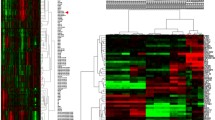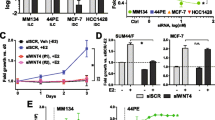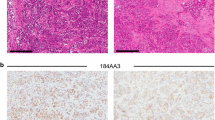Abstract
Mucinous breast cancer (MBC) is mainly a disease of postmenopausal women. Pure MBC is rare and augurs a good prognosis. In contrast, MBC mixed with other histological subtypes of invasive disease loses the more favorable prognosis. Because of the relative rarity of pure MBC, little is known about its cell and tumor biology and relationship to invasive disease of other subtypes. We have now developed a human breast cancer cell line called BCK4, in which we can control the behavior of MBC. BCK4 cells were derived from a patient whose poorly differentiated primary tumor was treated with chemotherapy, radiation and tamoxifen. Malignant cells from a recurrent pleural effusion were xenografted in mammary glands of a nude mouse. Cells from the solid tumor xenograft were propagated in culture to generate the BCK4 cell line. Multiple marker and chromosome analyses demonstrate that BCK4 cells are human, near diploid and luminal, expressing functional estrogen, androgen, and progesterone receptors. When xenografted back into immunocompromised cycling mice, BCK4 cells grow into small pure MBC. However, if mice are supplemented with continuous estradiol, tumors switch to invasive lobular carcinoma (ILC) with mucinous features (mixed MBC), and growth is markedly accelerated. Tamoxifen prevents the expansion of this more invasive component. The unexpected ability of estrogens to convert pure MBC into mixed MBC with ILC may explain the rarity of the pure disease in premenopausal women. These studies show that MBC can be derived from lobular precursors and that BCK4 cells are new, unique models to study the phenotypic plasticity, hormonal regulation, optimal therapeutic interventions, and metastatic patterns of MBC.









Similar content being viewed by others
Abbreviations
- MBC:
-
Mucinous breast cancer
- PR:
-
Progesterone receptor
- ER:
-
Estrogen receptor
- AR:
-
Androgen receptor
- GR:
-
Glucocorticoid receptor
- ILC:
-
Invasive lobular carcinoma
- IDC:
-
Invasive ductal carcinoma
- IDC NOS:
-
Invasive ductal carcinoma not otherwise specified
- MBCPure :
-
Pure mucinous breast cancer
- MBCMixed :
-
Mixed mucinous breast cancer
References
Tavassoli FA, Devilee P (eds) (2003) World Health Organization Classification of Tumours. Pathology and genetics of tumours of the breast and female genital organs. IARC Press, Lyon
Henson D, Tarone R (1979) A study of lobular carcinoma of the breast based on the third national cancer survey in The United States of America. Tumori 65(2):133–142
Dixon JM, Anderson TJ, Page DL, Lee D, Duffy SW (1982) Infiltrating lobular carcinoma of the breast. Histopathology 6(2):149–161
Martinez V, Azzopardi JG (1979) Invasive lobular carcinoma of the breast: incidence and variants. Histopathology 3(6):467–488
Steinbrecher JS, Silverberg SG (1976) Signet-ring cell carcinoma of the breast. The mucinous variant of infiltrating lobular carcinoma? Cancer 37(2):828–840
Li CI, Anderson BO, Porter P, Holt SK, Daling JR, Moe RE (2000) Changing incidence rate of invasive lobular breast carcinoma among older women. Cancer 88(11):2561–2569
Li CI, Weiss NS, Stanford JL, Daling JR (2000) Hormone replacement therapy in relation to risk of lobular and ductal breast carcinoma in middle-aged women. Cancer 88(11):2570–2577
O’Connor IF, Shembekar MV, Shousha S (1998) Breast carcinoma developing in patients on hormone replacement therapy: a histological and immunohistological study. J Clin Pathol 51(12):935–938
Pestalozzi BC, Zahrieh D, Mallon E, Gusterson BA, Price KN, Gelber RD, Holmberg SB, Lindtner J, Snyder R, Thurlimann B, Murray E, Viale G, Castiglione-Gertsch M, Coates AS, Goldhirsch A (2008) Distinct clinical and prognostic features of infiltrating lobular carcinoma of the breast: combined results of 15 International Breast Cancer Study Group clinical trials. J Clin Oncol 26(18):3006–3014. doi:10.1200/JCO.2007.14.9336
Zhao H, Langerod A, Ji Y, Nowels KW, Nesland JM, Tibshirani R, Bukholm IK, Karesen R, Botstein D, Borresen-Dale AL, Jeffrey SS (2004) Different gene expression patterns in invasive lobular and ductal carcinomas of the breast. Mol Biol Cell 15(6):2523–2536. doi:10.1091/mbc.E03-11-0786
Weigelt B, Geyer FC, Natrajan R, Lopez-Garcia MA, Ahmad AS, Savage K, Kreike B, Reis-Filho JS (2010) The molecular underpinning of lobular histological growth pattern: a genome-wide transcriptomic analysis of invasive lobular carcinomas and grade- and molecular subtype-matched invasive ductal carcinomas of no special type. J Pathol 220(1):45–57
Bertucci F, Orsetti B, Negre V, Finetti P, Rouge C, Ahomadegbe JC, Bibeau F, Mathieu MC, Treilleux I, Jacquemier J, Ursule L, Martinec A, Wang Q, Benard J, Puisieux A, Birnbaum D, Theillet C (2008) Lobular and ductal carcinomas of the breast have distinct genomic and expression profiles. Oncogene 27(40):5359–5372. doi:10.1038/onc.2008.158
Turashvili G, Bouchal J, Baumforth K, Wei W, Dziechciarkova M, Ehrmann J, Klein J, Fridman E, Skarda J, Srovnal J, Hajduch M, Murray P, Kolar Z (2007) Novel markers for differentiation of lobular and ductal invasive breast carcinomas by laser microdissection and microarray analysis. BMC Cancer 7:55. doi:10.1186/1471-2407-7-55
Turashvili G, Bouchalova K, Bouchal J, Kolar Z (2007) Expression of E-cadherin and c-erbB-2/HER-2/neu oncoprotein in high-grade breast cancer. Cesk Pathol 43(3):87–92
Ellis IO, Pinder SE, Bobrow L et al (2005) Classifying invasive carcinomas Pathology reporting of breast disease, vol. no 58. NHSBSP publications: The Royal College of Pathologists, Sheffield, pp 61–69
Rosen PP (2009) Rosen’s breast pathology, 3rd edn. Wolters Kluwer/Lippincott Williams & Wilkins, Philadelphia
Yu J, Bhargava R, Dabbs DJ (2010) Invasive lobular carcinoma with extracellular mucin production and HER-2 overexpression: a case report and further case studies. Diagn Pathol 5:36
Rosa M, Mohammadi A, Masood S (2009) Lobular carcinoma of the breast with extracellular mucin: new variant of mucin-producing carcinomas? Pathol Int 59(6):405–409. doi:10.1111/j.1440-1827.2009.02385.x
Haltas H, Bayrak R, Yenidunya S, Kosehan D, Sen M, Akin K (2012) Invasive lobular carcinoma with extracellular mucin as a distinct variant of lobular carcinoma: a case report. Diagn Pathol 7(1):91. doi:10.1186/1746-1596-7-91
Breslow A, Brancaccio ME (1976) Intracellular mucin production by lobular breast carcinoma cells. Arch Pathol Lab Med 100(11):620–621
Gad A, Azzopardi JG (1975) Lobular carcinoma of the breast: a special variant of mucin-secreting carcinoma. J Clin Pathol 28(9):711–716
Frost AR, Terahata S, Yeh IT, Siegel RS, Overmoyer B, Silverberg SG (1995) The significance of signet ring cells in infiltrating lobular carcinoma of the breast. Arch Pathol Lab Med 119(1):64–68
Merino MJ, Livolsi VA (1981) Signet ring carcinoma of the female breast: a clinicopathologic analysis of 24 cases. Cancer 48(8):1830–1837
Hull MT, Seo IS, Battersby JS, Csicsko JF (1980) Signet-ring cell carcinoma of the breast: a clinicopathologic study of 24 cases. Am J Clin Pathol 73(1):31–35
Rosen PP, Lesser ML, Kinne DW (1985) Breast carcinoma at the extremes of age: a comparison of patients younger than 35 years and older than 75 years. J Surg Oncol 28(2):90–96
Diab SG, Clark GM, Osborne CK, Libby A, Allred DC, Elledge RM (1999) Tumor characteristics and clinical outcome of tubular and mucinous breast carcinomas. J Clin Oncol 17(5):1442–1448
Weigelt B, Horlings HM, Kreike B, Hayes MM, Hauptmann M, Wessels LF, de Jong D, Van de Vijver MJ, Van’t Veer LJ, Peterse JL (2008) Refinement of breast cancer classification by molecular characterization of histological special types. J Pathol 216(2):141–150
Adsay NV, Merati K, Nassar H, Shia J, Sarkar F, Pierson CR, Cheng JD, Visscher DW, Hruban RH, Klimstra DS (2003) Pathogenesis of colloid (pure mucinous) carcinoma of exocrine organs: coupling of gel-forming mucin (MUC2) production with altered cell polarity and abnormal cell-stroma interaction may be the key factor in the morphogenesis and indolent behavior of colloid carcinoma in the breast and pancreas. Am J Surg Pathol 27(5):571–578
Zotter S, Hageman PC, Lossnitzer A, van den Tweel J, Hilkens J, Mooi WJ, Hilgers J (1988) Monoclonal antibodies to epithelial sialomucins recognize epitopes at different cellular sites in adenolymphomas of the parotid gland. Int J Cancer Suppl 3:38–44
Kato N, Endo Y, Tamura G, Katayama Y, Motoyama T (1999) Mucinous carcinoma of the breast: a multifaceted study with special reference to histogenesis and neuroendocrine differentiation. Pathol Int 49(11):947–955
Chu JS, Chang KJ (1999) Mucin expression in mucinous carcinoma and other invasive carcinomas of the breast. Cancer Lett 142(1):121–127
Fentiman IS, Millis RR, Smith P, Ellul JP, Lampejo O (1997) Mucoid breast carcinomas: histology and prognosis. Br J Cancer 75(7):1061–1065
Andre S, Cunha F, Bernardo M, Meneses e Sousa J, Cortez F, Soares J (1995) Mucinous carcinoma of the breast: a pathologic study of 82 cases. J Surg Oncol 58(3):162–167
Paramo JC, Wilson C, Velarde D, Giraldo J, Poppiti RJ, Mesko TW (2002) Pure mucinous carcinoma of the breast: is axillary staging necessary? Ann Surg Oncol 9(2):161–164
Norris HJ, Taylor HB (1965) Prognosis of mucinous (gelatinous) carcinoma of the breast. Cancer 18:879–885
Toikkanen S, Kujari H (1989) Pure and mixed mucinous carcinomas of the breast: a clinicopathologic analysis of 61 cases with long-term follow-up. Hum Pathol 20(8):758–764
Silverberg SG, Kay S, Chitale AR, Levitt SH (1971) Colloid carcinoma of the breast. Am J Clin Pathol 55(3):355–363
Rasmussen BB (1985) Human mucinous breast carcinomas and their lymph node metastases. A histological review of 247 cases. Pathol Res Pract 180(4):377–382
Gadre SA, Perkins GH, Sahin AA, Sneige N, Deavers MT, Middleton LP (2008) Neovascularization in mucinous ductal carcinoma in situ suggests an alternative pathway for invasion. Histopathology 53(5):545–553
Ross DT, Scherf U, Eisen MB, Perou CM, Rees C, Spellman P, Iyer V, Jeffrey SS, Van de Rijn M, Waltham M, Pergamenschikov A, Lee JC, Lashkari D, Shalon D, Myers TG, Weinstein JN, Botstein D, Brown PO (2000) Systematic variation in gene expression patterns in human cancer cell lines. Nat Genet 24(3):227–235
Jacobsen BM, Harrell JC, Jedlicka P, Borges VF, Varella-Garcia M, Horwitz KB (2006) Spontaneous fusion with, and transformation of mouse stroma by, malignant human breast cancer epithelium. Cancer Res 66(16):8274–8279
Pinto MP, Badtke MM, Dudevoir ML, Harrell JC, Jacobsen BM, Horwitz KB (2010) Vascular endothelial growth factor secreted by activated stroma enhances angiogenesis and hormone-independent growth of estrogen receptor-positive breast cancer. Cancer Res 70(7):2655–2664. doi:10.1158/0008-5472.CAN-09-4373
Kabos P, Haughian JM, Wang X, Dye WW, Finlayson C, Elias A, Horwitz KB, Sartorius CA (2011) Cytokeratin 5 positive cells represent a steroid receptor negative and therapy resistant subpopulation in luminal breast cancers. Breast Cancer Res Treat 128(1):45–55. doi:10.1007/s10549-010-1078-6
van Bokhoven A, Caires A, Maria MD, Schulte AP, Lucia MS, Nordeen SK, Miller GJ, Varella-Garcia M (2003) Spectral karyotype (SKY) analysis of human prostate carcinoma cell lines. Prostate 57(3):226–244
Richer JK, Jacobsen BM, Manning NG, Abel MG, Wolf DM, Horwitz KB (2002) Differential gene regulation by the two progesterone receptor isoforms in human breast cancer cells. J Biol Chem 277(7):5209–5218
Jacobsen BM, Jambal P, Schittone SA, Horwitz KB (2009) ALU repeats in promoters are position-dependent co-response elements (coRE) that enhance or repress transcription by dimeric and monomeric progesterone receptors. Mol Endocrinol 23(7):989–1000. doi:10.1210/me.2009-0048
Toikkanen S, Eerola E, Ekfors TO (1988) Pure and mixed mucinous breast carcinomas: DNA stemline and prognosis. J Clin Pathol 41(3):300–303
Weigelt B, Geyer FC, Horlings HM, Kreike B, Halfwerk H, Reis-Filho JS (2009) Mucinous and neuroendocrine breast carcinomas are transcriptionally distinct from invasive ductal carcinomas of no special type. Mod Pathol 22(11):1401–1414
Ko CD, Kim JS, Ko BG, Son BH, Kang HJ, Yoon HS, Cho EY, Gong G, Ahn SH (2003) The meaning of the c-kit proto-oncogene product in malignant transformation in human mammary epithelium. Clin Exp Metastasis 20(7):593–597
Jones C, Mackay A, Grigoriadis A, Cossu A, Reis-Filho JS, Fulford L, Dexter T, Davies S, Bulmer K, Ford E, Parry S, Budroni M, Palmieri G, Neville AM, O’Hare MJ, Lakhani SR (2004) Expression profiling of purified normal human luminal and myoepithelial breast cells: identification of novel prognostic markers for breast cancer. Cancer Res 64(9):3037–3045
Wan Y, Nordeen SK (2002) Overlapping but distinct gene regulation profiles by glucocorticoids and progestins in human breast cancer cells. Mol Endocrinol 16(6):1204–1214
Ghatge RP, Jacobsen BM, Schittone SA, Horwitz KB (2005) The progestational and androgenic properties of medroxyprogesterone acetate: gene regulatory overlap with dihydrotestosterone in breast cancer cells. Breast Cancer Res 7(6):R1036–R1050
Karey KP, Sirbasku DA (1988) Differential responsiveness of human breast cancer cell lines MCF-7 and T47D to growth factors and 17 beta-estradiol. Cancer Res 48(14):4083–4092
Sartorius CA, Shen T, Horwitz KB (2003) Progesterone receptors A and B differentially affect the growth of estrogen-dependent human breast tumor xenografts. Breast Cancer Res Treat 79(3):287–299
Waaseth M, Bakken K, Dumeaux V, Olsen KS, Rylander C, Figenschau Y, Lund E (2008) Hormone replacement therapy use and plasma levels of sex hormones in the Norwegian Women and Cancer postgenome cohort—a cross-sectional analysis. BMC Womens Health 8:1. doi:10.1186/1472-6874-8-1
Molavi D, Argani P (2008) Distinguishing benign dissecting mucin (stromal mucin pools) from invasive mucinous carcinoma. Adv Anat Pathol 15(1):1–17
Wilson TE, Helvie MA, Oberman HA, Joynt LK (1995) Pure and mixed mucinous carcinoma of the breast: pathologic basis for differences in mammographic appearance. AJR Am J Roentgenol 165(2):285–289
Dabbs DJ, Bhargava R, Chivukula M (2007) Lobular versus ductal breast neoplasms: the diagnostic utility of p120 catenin. Am J Surg Pathol 31(3):427–437. doi:10.1097/01.pas.0000213386.63160.3f
Capella C, Eusebi V, Mann B, Azzopardi JG (1980) Endocrine differentiation in mucoid carcinoma of the breast. Histopathology 4(6):613–630
Kehr EL, Jorns JM, Ang D, Warrick A, Neff T, Degnin M, Lewis R, Beadling C, Corless CL, Troxell ML (2012) Mucinous breast carcinomas lack PIK3CA and AKT1 mutations. Hum Pathol. doi:10.1016/j.humpath.2012.03.012
Eltorky M, Hall JC, Osborne PT, el Zeky F (1994) Signet-ring cell variant of invasive lobular carcinoma of the breast. A clinicopathologic study of 11 cases. Arch Pathol Lab Med 118(3):245–248
Raju U, Ma CK, Shaw A (1993) Signet ring variant of lobular carcinoma of the breast: a clinicopathologic and immunohistochemical study. Mod Pathol 6(5):516–520
Harris M, Vasudev KS, Anfield C, Wells S (1978) Mucin-producing carcinomas of the breast: ultrastructural observations. Histopathology 2(3):177–188
Chu PG, Weiss LM (2004) Immunohistochemical characterization of signet-ring cell carcinomas of the stomach, breast, and colon. Am J Clin Pathol 121(6):884–892. doi:10.1309/A09E-RYMF-R64N-ERDW
Foote FW, Stewart FW (1941) Lobular carcinoma in situ: a rare form of mammary cancer. Am J Pathol 17(4):491–496.3
Allred DC, Mohsin SK, Fuqua SA (2001) Histological and biological evolution of human premalignant breast disease. Endocr Relat Cancer 8(1):47–61
Khilko N, Wang J, Wei B, Hicks DG, Tang P (2010) Invasive lobular carcinomas do not express basal cytokeratin markers CK5/6, CK14 and CK17. Breast Cancer (Auckl) 4:49–55. doi:10.4137/BCBCR.S5037
Huiping C, Sigurgeirsdottir JR, Jonasson JG, Eiriksdottir G, Johannsdottir JT, Egilsson V, Ingvarsson S (1999) Chromosome alterations and E-cadherin gene mutations in human lobular breast cancer. Br J Cancer 81(7):1103–1110. doi:10.1038/sj.bjc.6690815
Di Saverio S, Gutierrez J, Avisar E (2008) A retrospective review with long term follow up of 11,400 cases of pure mucinous breast carcinoma. Breast Cancer Res Treat 111(3):541–547
Clayton F (1986) Pure mucinous carcinomas of breast: morphologic features and prognostic correlates. Hum Pathol 17(1):34–38
Komenaka IK, El-Tamer MB, Troxel A, Hamele-Bena D, Joseph KA, Horowitz E, Ditkoff BA, Schnabel FR (2004) Pure mucinous carcinoma of the breast. Am J Surg 187(4):528–532
Reeves GK, Beral V, Green J, Gathani T, Bull D, Million Women Study C (2006) Hormonal therapy for menopause and breast-cancer risk by histological type: a cohort study and meta-analysis. Lancet Oncol 7(11):910–918
Shousha S, Coady AT, Stamp T, James KR, Alaghband-Zadeh J (1989) Oestrogen receptors in mucinous carcinoma of the breast: an immunohistological study using paraffin wax sections. J Clin Pathol 42(9):902–905
Prat A, Ellis MJ, Perou CM (2012) Practical implications of gene-expression-based assays for breast oncologists. Nat Rev Clin Oncol 9(1):48–57. doi:10.1038/nrclinonc.2011.178
Acs G, Esposito NN, Kiluk J, Loftus L, Laronga C (2012) A mitotically active, cellular tumor stroma and/or inflammatory cells associated with tumor cells may contribute to intermediate or high Oncotype DX recurrence scores in low-grade invasive breast carcinomas. Mod Pathol 25(4):556–566. doi:10.1038/modpathol.2011.194
Kounalakis N, Diamond J, Rusthoven K, Horn W, Jindal S, Wisell J, Klein CE, Elias A, Finlayson C, Borges VF (2011) Diagnosis of invasive lobular carcinoma in a young woman presenting with pleomorphic lobular carcinoma in situ on core biopsy. Oncology (Williston Park) 25(4):351–356
Cho LC, Hsu YH (2008) Expression of androgen, estrogen and progesterone receptors in mucinous carcinoma of the breast. Kaohsiung J Med Sci 24(5):227–232. doi:10.1016/S1607-551X(08)70146-3
Melamed MR, Robbins GF, Foote FW Jr (1961) Prognostic significance of gelatinous mammary carcinoma. Cancer 14:699–704
Komaki K, Sakamoto G, Sugano H, Morimoto T, Monden Y (1988) Mucinous carcinoma of the breast in Japan. A prognostic analysis based on morphologic features. Cancer 61(5):989–996
Stanley MW, Tani EM, Skoog L (1989) Mucinous breast carcinoma and mixed mucinous-infiltrating ductal carcinoma: a comparative cytologic study. Diagn Cytopathol 5(2):134–138
Rosen PP, Wang T-Y (1980) Colloid carcinoma of the breast. Analysis of 64 patients with long term followup. Am J Clin Pathol 73:304
Pusztai L, Sotiriou C, Buchholz TA, Meric F, Symmans WF, Esteva FJ, Sahin A, Liu ET, Hortobagi GN (2003) Molecular profiles of invasive mucinous and ductal carcinomas of the breast: a molecular case study. Cancer Genet Cytogenet 141(2):148–153
Acknowledgments
These studies were supported by The Avon Foundation for Women (BMJ, KBH), NIH NCI CA026869, the National Foundation for Cancer Research, and the Breast Cancer Research Foundation (KBH). We are grateful to the University of Colorado Cancer Center Sequencing and Cytogenetics Core laboratories for technical support, to Dr. Hany Abdel-Hafiz for providing PCR primers for pS2 and CathD, and we thank Robert W. Burke for helpful discussions. All authors edited and approved the final manuscript.
Conflict of interest
The authors declare that they have no conflict of interest.
Author information
Authors and Affiliations
Corresponding author
Electronic supplementary material
Below is the link to the electronic supplementary material.
Rights and permissions
About this article
Cite this article
Jambal, P., Badtke, M.M., Harrell, J.C. et al. Estrogen switches pure mucinous breast cancer to invasive lobular carcinoma with mucinous features. Breast Cancer Res Treat 137, 431–448 (2013). https://doi.org/10.1007/s10549-012-2377-x
Received:
Accepted:
Published:
Issue Date:
DOI: https://doi.org/10.1007/s10549-012-2377-x




